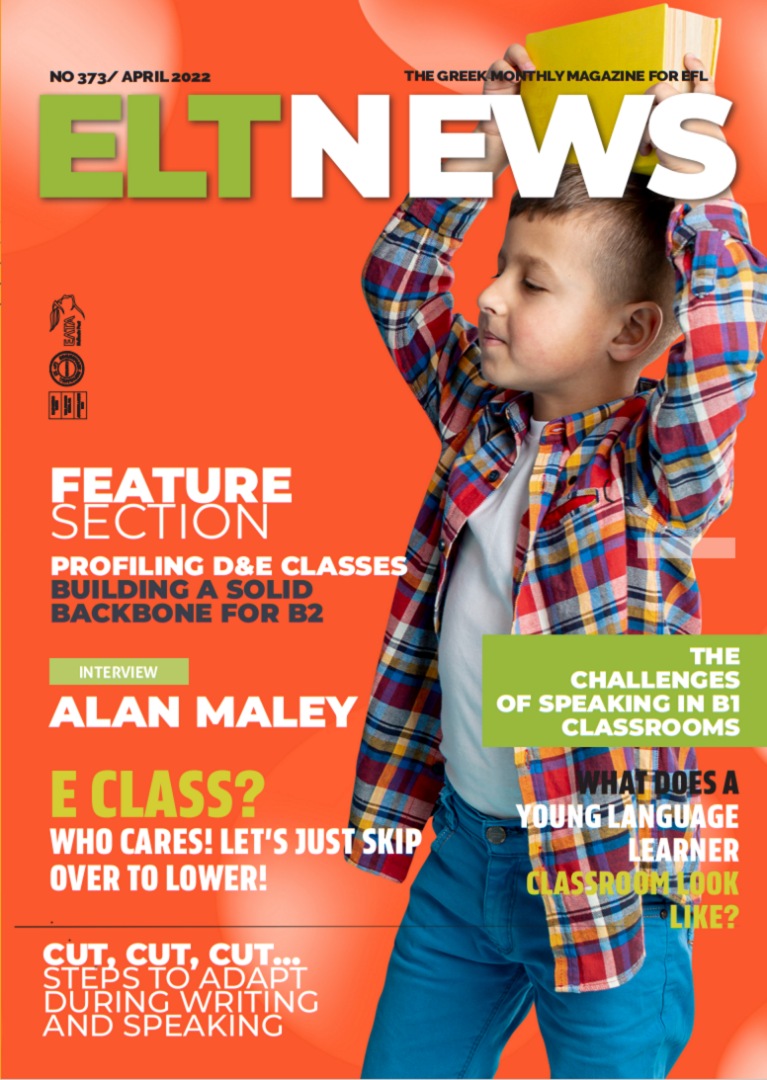The current issue of ELT NEWS focuses on B1 Level. I would dare say that this level is very challenging. Learners have covered the basics of the language regarding vocabulary and grammar and are ready to explore more demanding learning areas. They are required to use prior knowledge and experiences and develop language awareness -that is how language works.
Text by: Anastasia Spyropoulou
Language Awareness comprises five main features:
It involves an ongoing investigation of language as a dynamic phenomenon rather than as a fixed body of established rules.
It involves learners in talking about language, often to each other.
It considers the involvement of learners in exploration and discovery essential.
It aims at developing not only the learners’ knowledge and understanding of language but also their learning skills, thus promoting learner independence.
It aims at involving learners on both a cognitive and an affective level.
Language Awareness tasks are sometimes called ‘discovery tasks’ because by investigating the language, the learners ‘discover’ how it works.
In terms of promoting greater learner autonomy, a wide range of strategies and classroom tasks have been recommended by linguists. More recent views have come to acknowledge the essentially interdependent relationship of teachers and learners. This relationship aims at developing intrinsic motivation, and the encouragement of learner self-monitoring. Activities should be based on the premise that the teacher can promote greater learner initiative and involvement.
Engagement in language learning
Most language learners would agree that opportunities to communicate are important. But the question is whether studying is also necessary. We have perhaps all observed that very young children pick up language quite quickly without studying. But all the learners, including adults, need to learn language explicitly as well. Just communicating is not quite enough. If they study hard and participate in meaningful communication, does this guarantee language learning? Well, it doesn’t. Many learners are unsuccessful despite their teacher’s best efforts. Why?
Part of the answer might lie in their engagement or lack of engagement. Learners who are fully engaged in the task are focused, willing, and interactive. They are focused because they concentrate on the task, rather than thinking about something else while they’re doing it. Emotionally, they have a positive attitude to the task and they’re not blocked by, for example, anxiety. Ideally, they’re also interactive. So if it is a pair or a group work task, they exercise their autonomy by collaborating. From time to time they also take initiatives.
In the right learning environment, where the level of cognitive challenge and the level of difficulty is just right, the engaged learning may even experience what is called ‘flow’. Flow is a feeling of being completely immersed in the activity, when you forget about time and your surroundings. Engagement can really facilitate learning and be very satisfying for the learner.
What might help or hinder language learning?
How does a teacher know if learners are fully engaged or not? Typical off-task behaviours include: physical (rocking on chair, kicking table, tapping stationery, walking around room etc.), verbal (disrupting peers, asking irrelevant questions, calling out/yelling etc.). On task behaviours include: flipping through books/dictionaries to find/check vocabulary, asking peers/teacher pertinent questions, taking notes, having fun with the language by ‘playing’ with it - pronunciation, word order, checking in with group members.
If a student is immersed, they will visibly exhibit signs of this immersion. If class discussion is active like a hive, this means they are engaged and wish to discuss the topic with one another to get other opinions or relate to peers who share their opinion. However, this isn’t always an indicator of immersion as social anxiety could be a factor, meaning that some kids aren’t comfortable speaking aloud in front of peers despite being intrigued by a topic.
Experienced teachers know what engaged students look and sound like, though ‘lively conversation’ may mean different things in different contexts. In addition body language and gestures tells you a lot about their engagement level. If you observe that they are sharing information, write and ask questions related to the task, they might be on the right track.
Spotting disengagement could be harder. Researchers have found that students sometimes simulate engagement. The closer the teacher gets to them, the busier they become. Also, some learners may be socially engaged (e.g. talking and laughing), but not actually paying much attention to the language they are learning. Others may be concentrating on the teaching point, but not saying much.
One way of getting a truer picture of the students’ engagement is for teachers to observe each other’s class. Both (or several) teachers first agree what the learning objective of the lesson is. The observing teacher then focuses their observation on the learners (not on their fellow teacher). Afterwards, the teachers get together and discuss to what extent specific learners engaged in the lesson and to what extent the learning objectives were met for those students.
